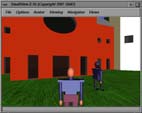Multi-user Virtual Reality on the Internet
by Wolfgang Broll
The Computer Supported Cooperative Work/CSCW & 3D worlds project at GMD's Institute for Applied Information Technology focuses on the development of mechanisms and techniques to support collaborative virtual environments on the Internet. Main issues are the representation and interaction of multiple users distributed world-wide and the necessary enabling network infrastructure. A prototype of a distributed Virtual Reality System and the scaleable network protocol DWTP (Distributed Worlds Transfer and Communication Protocol) have been realised by this project.
The realised prototype uses VRML (Virtual Reality Modelling Language) the standard description language for the transmission of 3D data on the Internet as a scene description language. The system consists of the multi-user VRML browser SmallView and a number of daemons. SmallView provides support for VRML 1.0, VRML 2.0, and extensions for the representation of users by avatars. Support for communication between distributed users is provided by integrated audio and text chat facilities. Sophisticated interaction mechanisms going beyond the VRML standard in order to enable real collaboration between users are provided. Among those are mechanisms to resolve access conflicts and to handle multi-user interactions. The prototype system uses DWTP for network communication.
Distributed Worlds Transfer
DWTP is an application layer protocol similar to HTTP (Hypertext Transfer Protocol). It provides support for large scale distributed virtual worlds, independent of the underlying network protocols. It uses various standard network protocols of the underlying network layers to provide effective transmission facilities for the various data types used in distributed virtual environments. The protocol is independent of a particular Virtual Reality System.

Screenshot of the multi-user VRML browser SmallView.
The supported data types used for communication include: the reliable transmission of large files for virtual world descriptions between two peers, the reliable or unreliable transfer of short messages or events between a large number of participants, and the transfer of stream data (eg audio). The protocol uses Internet Protocol Multicasting, UDP/IP (Internet User Datagram Protocol/Internet Protocol) and TCP/IP (Transmission Control Protocol/Internet Protocol) depending on the data type to transfer and availability at the local network. The protocol forces a direct connection between peers by Internet Protocol Multicasting thus not requiring any central servers. Nevertheless several daemons are required to provide certain services to the connected participants. These include download services for new participants as well as mechanisms to make unreliable connections - such as UDP unicast and multicast - reliable. More information on the web at: http://orgwis.gmd.de/VR/
Please contact:
Wolfgang Broll - GMD
Tel: +49 2241 14 2715
E-mail: wolfgang.broll@gmd.de
